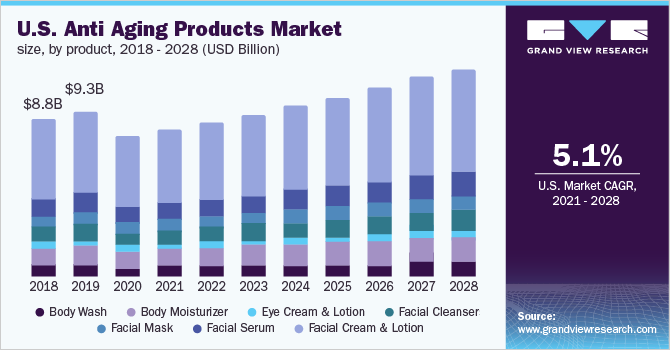Anti-Aging Products Industry Overview
The global anti-aging products market size is expected to reach USD 61.71 billion by 2028, according to a new report by Grand View Research, Inc. It is expected to expand at a CAGR of 5.4% from 2021 to 2028. Rising awareness among consumers regarding age-related skin problems such as fine lines, wrinkles, and dullness of skin, coupled with their increasing propensity to spend on products that help them to proclaim their skin youthfulness, is expected to drive the market demand throughout the forecast period.

Rising inclination toward green and plant-based products has piqued the interest of many manufacturers to provide chemical-free products. For instance, in September 2021, NOW Solutions, a U.S.-based brand dealing in clean ingredient beauty products, recently added seven new products to the line, including a plant-based retinol alternative skin renewal serum, which is formulated to be used for anti-aging skin smoothing and refining.
Anti-Aging Products Market Segmentation
Grand View Research has segmented the global anti-aging products market on the basis of product, distribution channel, and region:
Based on the Products Insights, the market is segmented into Body Wash, Body Moisturizer, Eye Cream & Lotion, Facial Cleanser, Facial Mask, Facial Serum, and Facial Cream & Lotion.
- The facial cream and lotion segment held the largest share of over 50.0% in 2020 and is expected to maintain its lead over the forecast period. These are specially formulated products to help the facial skin retain moisture, firmness, and elasticity, thus preventing wrinkles and lines.
- Furthermore, with the growing concerns over animal welfare and the environment, a number of consumers are opting for cruelty-free products, which has increased the demand for vegan or plant-based ingredient blends in skincare products.
- The eye cream and lotion segment is expected to register the fastest CAGR of 6.6% from 2021 to 2028. These creams are designed for the treatment of the sensitive area beneath the eyes. The skin around the eyes is highly sensitive and is prone to lose elasticity.
- Various well-established brands offer eye creams with a high concentration of active pharmaceutical ingredients such as ceramides, niacinamide, and alpha-hydroxy acids that diminish or eliminate dark circles, age lines, and wrinkles as well as moisturize and treat puffiness of the eyes.
Based on the Distribution Channel Insights, the market is segmented into Hypermarket & Supermarket, Pharmacy & Drug Stores, Specialty Store, Online, and Others.
- The hypermarket and supermarket segment accounted for the largest share of over 45.0% in 2020.
- The segment is projected to maintain its lead throughout the forecast period owing to the high consumer inclination toward purchasing skincare products from supermarkets and hypermarkets as these places enjoy high customer preferences.
- The specialty store segment is expected to register the fastest CAGR of 6.3% from 2021 to 2028.
Anti-aging Products Regional Outlook
- North America
- Europe
- Asia Pacific
- Latin America
- Middle East & Africa (MEA)
Key Companies Profile & Market Share Insights
The market for anti-aging products has a presence of many multinationals as well as domestic manufacturers operating in the market making the product pricing highly competitive. Also, many of the retailers in the cosmetic sector have entered the marketing in order to cater to growing consumer demand. For instance, in October 2018, The Face Shop, a South Korea-based skincare manufacturer, retailer, and franchiser, launched a new product line Yehwadam, focusing on brightening and antiaging concerns.
Some prominent players in the global anti-aging products market include: -
- Estee Lauder Inc.
- Procter & Gamble
- Beiersdorf Limited
- com & Age Sciences Inc.
- Shiseido
- Unilever
- L’Oreal Paris
- Revlon
- Oriflame Cosmetics
- Avon Products, Inc.
Order a free sample PDF of the Anti-aging Products Market Intelligence Study, published by Grand View Research.


No comments:
Post a Comment